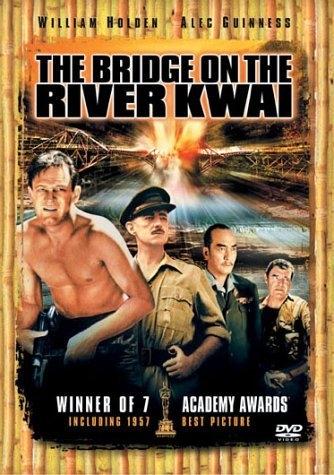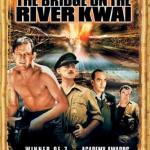It is clear from Scene One that although Saito and Nicholson share a fierce devotion to their roles as military officers, they differ in their interpretation of what it means to be a soldier. Saito holds fast to the concept of death before dishonor, while Nicholson believes that a true soldier stands proud, even in the face of defeat.
"What do you know of the soldier's code? Of bushido?" asks Saito. "Nothing!" And turning to Nicholson's rag-tag band of troops, he declares, "English prisoners, notice I do not say English soldiers. From the moment you surrendered, you ceased to be soldiers. All men will work. your officers will work beside you. This is only just, for it is they who betrayed you by surrender. Your shame is their dishonor. It is they who told you 'better to live like a coolie than die like a hero'. It is they who brought you here, not I."
When Nicholson and his troops arrive at Camp 16, Commander Shears (William Holden) is already there, having survived the sinking of his naval ship, only to be captured by the Japanese army. Early on in the film, the story splits into two plots when William Holden escapes through the perilous island terrain and is rescued, first by a group of villagers, and then by the British, who transport him to a military hospital in Ceylon. And just when he thinks he's on his way home with a medical discharge, along comes Major Warden (Jack Hawkins) of the British Special Forces with a mission that, on a rather dishonorable technicality, Shears can't refuse: a trek back into the Thai jungle to blow up the bridge over the River Kwai.
Meanwhile, back at Camp 16, after an intense stand-off between Nicholson and Saito, the British officers have been placed in charge of overseeing the building of the bridge. In a conversation between Nicholson and the camp medic, Dr. Clipton asks, "Are you convinced that building this bridge is a good idea? To which Nicholson replies, "You don't agree that the men's morale is high, discipline has been restored, their condition has been improved? Are they a happier lot or aren't they?"
Forgive me sir," says Clipton, "but what they are doing could be considered collaboration with the enemy. Perhaps even as treasonable activity."
"We're prisoners of war," Nicholson points out. "We haven't the right to refuse work."
"But must we work so well?" asks Clipton. "Must we build them a better bridge than they could have built themselves?"
To which Nicholson proudly replies, "Take a good look, Clipton. One day the war will be over. And I hope that the people who use this bridge in years to come will remember how it was built and who built it. Not a gang of slaves, but soldiers. British soldiers, even in captivity."
As the film approaches its dramatic denouement, the scenes toggle back and forth between Lt. Colonel Nicholson's progress on the bridge, and Commander Shears' progress through the jungle, until the dawn of May 12. As the demolition team lurks along the banks of the river below, poised to detonate the charge when the train arrives, Nicholson and Saito take a final walk across the bridge that represents three months of struggle between them. And then, in the final moments of the film, things go terribly wrong.
Based on the novel Le Pont de la Rivière Kwaï by Pierre Boulle, The Bridge on the River Kwai debuted in 1957 to critical acclaim and award-winning recognition, including Best Director for David Lean, Best Actor for Alec Guinness, Best Cinematography by Jack Hildyard, Best Picture for Sam Spiegel, Best Film Editing by Peter Taylor, Best Music by Malcolm Arnold and Best Adapted Screenplay by Carl Foreman, Michael Wilson, and Pierre Boulle. And in 1997, the film was preserved in the United States Library of Congress National Film Registry as "culturally, historically, or aesthetically significant". As movies go, The Bridge on the River Kwai is old-school in every detail, from plot and script, to casting and directing, and the special effects are brick-and-mortar all the way. But when it comes to old school, The Bridge on the River Kwai is as good as it gets.
 ThingsAsian
ThingsAsian

















